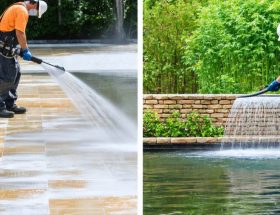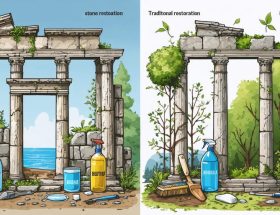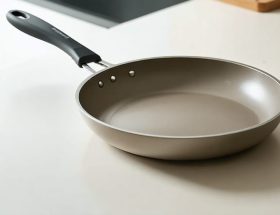Biological weathering silently transforms our stone surfaces as living organisms – from microscopic bacteria to persistent plant roots – break down even the most resilient rocks through natural weathering and erosion processes. This often-overlooked form of deterioration costs property owners millions annually in repairs and replacement, yet remains one of the most preventable forms of stone damage. Understanding how organisms interact with stone surfaces isn’t just academic – it’s essential for preserving everything from historic monuments to modern architectural features. As lichens secrete acids that etch limestone facades and moss retention creates moisture traps that accelerate decay, the impact of biological weathering extends far beyond simple surface discoloration. Whether you’re an architect designing with natural stone or a property manager maintaining stone assets, recognizing the early signs of biological weathering can mean the difference between simple maintenance and costly restoration.
Understanding Biological Weathering
Chemical vs. Physical Biological Weathering
Biological weathering operates through both chemical and physical mechanisms, each affecting stone materials in distinct ways. In chemical biological weathering, organisms secrete various compounds that react with the stone’s minerals. Lichens, for instance, produce organic acids that dissolve calcium carbonate in limestone and marble, gradually breaking down these materials at a molecular level. Bacteria and fungi similarly release acids and other compounds that can alter the stone’s chemical composition over time.
Physical biological weathering, on the other hand, involves mechanical forces exerted by growing organisms. Root systems from plants and trees can penetrate existing cracks and crevices in stone, gradually widening them as they grow. This process, known as root wedging, can cause significant structural damage to stone structures and formations. Similarly, some species of burrowing organisms can create holes and tunnels in softer stones, compromising their integrity.
The interaction between these two processes often accelerates stone deterioration. For example, when lichens chemically weather a stone’s surface, they create microscopic pits and irregularities that can trap moisture and organic matter. This provides ideal conditions for moss growth, which can then exert physical pressure on the stone while simultaneously harboring moisture that promotes further chemical breakdown.
Understanding these distinct mechanisms is crucial for stone preservation, as different types of biological weathering may require different prevention and treatment approaches. While chemical damage might need biocidal treatments, physical damage could require mechanical removal of organisms and structural reinforcement.

Common Biological Agents
Bacteria and Fungi
Bacteria and fungi are among the most significant biological agents that contribute to stone weathering. These microorganisms establish themselves on stone surfaces, forming biofilms that can penetrate deep into the material’s pores. As they grow and multiply, they produce organic acids and other metabolic byproducts that gradually break down the stone’s mineral structure.
Various species of bacteria, particularly those that oxidize sulfur and nitrifying bacteria, accelerate the deterioration process by converting atmospheric compounds into acids. These acids directly attack the stone’s calcium carbonate content, leading to surface erosion and structural weakening. Similarly, fungi species like Aspergillus and Penicillium create an intricate network of hair-like structures called hyphae that physically penetrate the stone, widening existing cracks and creating new ones.
The presence of these microorganisms is often visible as dark stains, green or black patches, or powdery deposits on stone surfaces. In humid environments, their growth can be particularly aggressive, especially on limestone, marble, and sandstone. The damage they cause isn’t just aesthetic – over time, these organisms can compromise the structural integrity of stone elements.
Modern studies have shown that some bacteria strains can cause significant deterioration within just a few years, particularly in urban environments where pollution provides additional nutrients for microbial growth. This understanding has led to the development of specialized treatments and preventive measures in stone conservation.
Lichens and Mosses
Lichens and mosses are among the most common biological agents affecting stone surfaces. These resilient organisms establish themselves on stone surfaces by secreting compounds that help them adhere and extract nutrients from the rock. While they may create an aesthetically pleasing, aged appearance, their presence can lead to significant deterioration over time.
Lichens, which are actually a symbiotic partnership between fungi and algae, produce organic acids that gradually dissolve mineral components within the stone. Their root-like structures, called rhizines, penetrate microscopic cracks and crevices, gradually widening them through both chemical and physical processes. As these organisms grow and expand, they can create a network of tiny fissures that allow water to penetrate deeper into the stone.
Mosses typically establish themselves in areas where moisture consistently accumulates on stone surfaces. They form dense, carpet-like growths that trap water against the stone surface, creating ideal conditions for further biological colonization and chemical weathering. Their presence can be particularly problematic in shaded areas or regions with high rainfall.
Both organisms can cause significant surface erosion and contribute to the formation of patinas on stone surfaces. In historic structures and monuments, their presence often requires careful management to balance preservation needs with the natural aging process of stone materials.

Plant Roots and Other Vegetation
Plant roots are among the most powerful agents of biological weathering, capable of causing both physical and chemical alterations to stone surfaces. As roots grow and expand, they can exert tremendous pressure on rocks, forcing their way into existing cracks and crevices. This mechanical action gradually widens these openings, leading to the breakdown of even the most durable stone materials.
The process becomes particularly concerning when vegetation takes hold in building facades or stone installations. Root systems can generate pressures exceeding 300 pounds per square inch, enough to fragment solid rock over time. Moreover, roots secrete organic acids that chemically react with minerals in the stone, accelerating the weathering process.
Climbing plants like ivy and Virginia creeper pose additional risks. While their aerial roots may seem harmless initially, they can penetrate microscopic fissures and gradually expand them. These plants also retain moisture against stone surfaces, creating ideal conditions for further biological weathering.
In natural settings, this process plays a vital role in soil formation and ecosystem development. However, in architectural applications, it can compromise structural integrity and aesthetic appeal. Regular maintenance, including the removal of unwanted vegetation and sealing of potential entry points, is essential to prevent root-related damage to stone structures.
Prevention and Protection Strategies

Surface Treatments and Sealers
Protecting stone surfaces from biological weathering requires effective surface treatments and sealers that create barriers against organic growth while maintaining the stone’s natural appearance. Today’s modern conservation techniques offer various solutions, each suited to different stone types and environmental conditions.
Penetrating sealers represent the first line of defense, forming an invisible barrier that allows the stone to breathe while preventing moisture infiltration. These products typically contain silane or siloxane compounds that bond with the stone’s mineral structure, providing long-lasting protection without altering the surface appearance.
Water-based biocides can be applied periodically to prevent the growth of algae, lichens, and moss. These treatments are particularly effective when combined with proper sealing and regular maintenance. For best results, choose pH-neutral formulations specifically designed for natural stone to avoid potential chemical damage.
Anti-microbial coatings represent the latest advancement in stone protection. These specialized treatments incorporate nano-particles that actively resist biological growth while remaining completely invisible to the naked eye. Though more expensive than traditional sealers, they often provide superior protection and require less frequent reapplication.
For historic or particularly valuable stone surfaces, sacrificial coatings may be appropriate. These removable layers protect the underlying stone while allowing future conservators to reverse the treatment if needed. Regular monitoring and maintenance of any surface treatment is essential, as effectiveness typically diminishes over time due to environmental exposure and wear.
Maintenance and Cleaning Protocols
Regular maintenance is crucial in preventing biological weathering on stone surfaces. A proactive cleaning schedule, combined with sustainable restoration methods, can significantly extend the life of stone materials while preserving their natural beauty.
Start with regular inspection of stone surfaces, particularly in areas prone to moisture retention or shade. Remove debris, leaves, and organic matter promptly, as these can create ideal conditions for biological growth. For routine cleaning, use pH-neutral stone cleaners and soft brushes to avoid scratching the surface.
Apply preventive treatments quarterly or bi-annually, depending on environmental conditions. These may include:
– Gentle pressure washing (avoiding high pressure that could damage the stone)
– Application of EPA-approved biocides
– Installation of proper drainage systems
– Ensuring adequate ventilation around stone surfaces
For existing biological growth, implement a three-step approach:
1. Gentle cleaning with appropriate stone-safe solutions
2. Complete drying of the affected area
3. Application of protective sealants designed for natural stone
Remember to avoid harsh chemicals or abrasive cleaning methods that could compromise the stone’s integrity. Instead, opt for environmentally friendly cleaning solutions that are specifically formulated for natural stone. Regular maintenance not only prevents biological weathering but also helps maintain the stone’s aesthetic appeal and structural integrity for years to come.
When to Seek Professional Help
While minor biological weathering is common and can often be addressed through regular maintenance, certain situations require immediate professional intervention. If you notice rapid deterioration, extensive discoloration, or structural concerns, it’s time to consult a stone preservation specialist who understands preservation best practices.
Key indicators that warrant expert assessment include:
Deep-seated biological growth that penetrates beyond surface level
Significant material loss or flaking of the stone surface
Unusual patterns of deterioration that occur rapidly
Structural instability or visible cracks developing alongside biological growth
Heritage or historically significant stones showing signs of degradation
Large-scale infestations affecting multiple stone surfaces
Professional conservators bring specialized knowledge and equipment that enables them to:
Accurately identify the specific organisms causing the damage
Assess the extent of deterioration below the surface
Implement appropriate treatment methods without causing additional harm
Document the condition and create long-term preservation strategies
Provide preventive measures to avoid future biological weathering
Timing is crucial when dealing with biological weathering. Early intervention by qualified professionals can prevent extensive damage and reduce restoration costs. For commercial properties or architectural features, regular professional assessments should be scheduled as part of routine maintenance protocols. This proactive approach helps identify potential issues before they become severe and ensures the longevity of stone installations.
Remember that DIY solutions, while tempting, may cause unintended damage when dealing with advanced biological weathering. Professional stone conservators have access to specialized treatments and testing methods that aren’t available to the general public, ensuring the most effective and safe restoration approach for your stone surfaces.
Biological weathering poses a significant threat to natural stone surfaces, but with proper understanding and preventive measures, its impact can be effectively managed. The key to protecting stone materials lies in regular maintenance, proper drainage systems, and swift response to early signs of biological growth. By implementing appropriate cleaning protocols, ensuring adequate ventilation, and maintaining protective sealants, property owners can significantly extend the life and preserve the beauty of their stone installations. Remember that prevention is more cost-effective than restoration, and early intervention can prevent extensive damage. With increasing awareness of biological weathering processes and advancing protection technologies, we can better preserve our valuable stone surfaces for future generations. Professional consultation and regular assessments remain crucial components of any comprehensive stone maintenance strategy.










